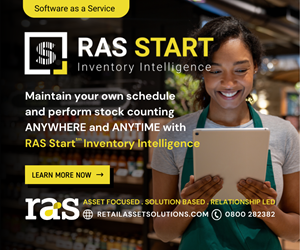Retail Environment
Collaboration on food waste reduction
In the English language, the word “set” reportedly has the most number of different meanings - 464 according to the Oxford English Dictionary. The word “run,” with 396 meanings, is apparently making a strong bid to catch up, and somewhere not far behind is probably the word “collaboration.”
Even just in the context of retailing, it has many meanings. To some, it can mean working with those you would traditionally see in a commercial relationship as your adversary. To others, collaboration is about one party complying with the needs and requests of the other party. While to others, it can mean working together towards one common purpose for the benefit of each party.
Given the sheer number of mentions of collaboration in retail publications, conferences, and talks, the ECR Community Shrinkage and On-shelf Availability Group felt there was an opportunity to bring some clarity and definition to what is really meant by collaboration, with a particular focus on reducing food waste in retail.
To this end, a team of academics and practitioners from the world of fast-moving consumer goods (FMCG) manufacturers and retailers have been working together for the last eighteen months, with the support of food waste experts from Oliver Wyman, to identify the true “DNA” of collaboration.
In this article, we will detail why we chose food waste as the focus of our research on collaboration. We will then share what we have found to be some of the key barriers to collaboration and then some of the early insights from the project. We will close by describing a possible next step for retail loss prevention professionals.
The Value of Using Food Waste as a Case Study
We chose food waste for two main reasons:
- Food Waste Matters. One-third of food produced for human consumption is wasted. It is now an industry priority, and bold waste-reduction targets have been set by a number of bodies, including the Consumer Goods Forum.
- Collaboration Is in Demand. Top retail managers have called out the need for collaboration. George Plassat, the CEO of Carrefour, said, “Food waste is a collective challenge in which all stakeholders must take action.” That comment was further underlined by Dave Lewis, the CEO of Tesco, who said, “At Tesco, we’re committed to tackling food waste not only in our own operations but also through strong and effective partnerships with our suppliers and by helping our customers reduce waste and save money.”
In short, food waste is not only highly relevant to our member organisations and the shoppers they serve, but also seen as a priority by senior business leaders who have called out improved collaboration as a strategic priority. Thus, it made sense for the ECR Group to focus this project on food waste.
Understanding the Barriers to Collaboration
Despite the apparent relevance and sense of urgency for greater collaboration on food waste, many attending the workshops organised by the ECR Group expressed frustration at the current state of collaboration. As one member put it, “We all know what we have to do together to reduce food waste, but it’s not happening.” They then went on to ask, “What does it really take for us to get to a better state of collaboration?”
To begin to answer this question, the research group had to first identify the major barriers to improving collaboration. Five key obstacles were thought to be particularly relevant:
- Incentives. The reward and recognition schemes for most suppliers’ category managers and retail buyers do not include food waste, thus collaboration is rarely included as a metric or consideration in their assortment discussions, annual contracts, or daily interactions on supply.
- Competing Internal Priorities. Fresh suppliers are being asked to collaborate with multiple stakeholders within each of their customers, each with slightly different requirements that have different impacts on food waste. By way of example, the supplier and the supply-chain manager of a retailer may wish to increase the case counts from twenty-four units per case to forty-eight units to reduce packaging costs and the number of journeys to the store. However, the supplier’s category manager and the retail buyer may want smaller case counts from twenty-four units to twelve units to increase sales and the depth of distribution. If retailers and suppliers cannot be perfectly aligned internally on their requirements, collaboration will be problematic.
- Data Sharing. Collaboration can only happen when data is shared, yet accessibility to the right level of inventory, food waste, and sales data by store and by SKU is a barrier, with some retailers choosing as a principle not to share data.
- Benefit Sharing. While multiple case studies consistently demonstrate that collaboration can unlock huge value, often projects can stall at the very start when organisations fail to reach agreements on how to split any benefits that may be realised.
- Consistency and Capacity. Collaboration is about long-term thinking; however, suppliers’ category managers and buyers are often tasked to think short term. Further, the capacity required for collaboration, in terms of days and hours, can simply not be available.
The Role of Better Collaboration in Food Waste Reduction
There is much that retailers and producers can do to reduce food waste without the need for collaboration with other organisations. However, there are also some transformational changes that can only be delivered when organisations collaborate. Below are a few examples.
Range and Assortment
Joint product innovation from initial conceptualisation to eventual product launch that considers and designs in potential food waste reduction benefits, for example, longer shelf life, shorter supply chains, or reduced case sizes.
Joint development of range and planograms by type of store and format using metrics such as the fresh case cover (FCC) that can prevent food waste. By way of explanation, the FCC “score” is a function of the weekly sales rate, the shelf life, and minimum case sizes, and can help the range and space planners identify the SKU/store combinations with the greatest risk to food waste. To mitigate that risk, the planners can reduce the range to potentially increase the sales rates of each remaining SKU. They can seek ways to extend shelf life or work with the supply chain to reduce minimum case sizes.
Joint development of innovative packaging and display fixtures that can improve shelf life and give the impression of abundance without the need for excessive volumes of product on display and the consequent higher risk of food waste.
Planning
Joint forecasting of forward sales through the combination of available information that also includes past waste performance data. Joint planning of promotional volume to also include using food waste data from previous promotions.
Supply Chain
Joint short-term demand generation activities to sell excess quantities to the consumer to try and avoid waste. To illustrate the benefits and results from collaboration, the ECR Group has started to collect evidence from joint projects. Below are examples of three case studies:
Case Study 1:
One retailer responded to the news from its suppliers of a bumper harvest of cauliflowers with the development of new in-store demand-generating promotions (recipes, extra displays, and price discounts) that helped sell through to the shopper the more-than-forecasted volumes, ensuring that produce was sold, and not left to rot.
Case Study 2:
One manufacturer worked with a retailer to create a new product made up of unused raw materials, thus saving those materials from being wasted. This new line item is now being sold in the retailer’s stores.
Case Study 3:
One manufacturer and retailer partner worked together to improve the percentage of every crop that was purchased by consumers by repurposing and processing the off-standard and oddly shaped products into other products such as ready-made meals and frozen varieties of the product that would then be sold in the retailer’s stores. This collaboration prevented significant quantities of product being fed to animals or thrown away while also improving profitability for both organisations.
Towards Better Collaboration
While the ECR Group has yet to finalise the full details of the maturity model, three major findings have already emerged from the research.
Finding 1:
Collaboration on food waste must be declared a business priority by the organisation. Organisations that are mostly likely to be strong collaborators on food waste are also likely to have declared at the CEO level that food waste reduction fits their company strategies. In these organisations they will have:
- Awareness that food waste reduction is critical to the achievement of the company’s corporate goals and must be prevention focused and end to end - from farm to fork.
- A vision and an alignment on how to systematically share sales and food waste data.
- Confidence that there is a business case for collaboration that ensures a win-win for both suppliers and retailers.
- An approach that is well structured with aligned rules of engagement for collaboration.
- Further, those organisations that have recognised the importance of collaboration on food waste will typically:
- Promote internally a collaborative mindset where multidisciplinary thinking and collaboration are actively fostered and incentivised.
- Identify the right people in the right positions to be dedicated to delivering successful collaborative work.
- Ensure there is full transparency of key performance indicators, such as cost and time, across the whole supply chain.
- Ensure the full availability of timely, accurate, and formatted inventory data.
- Invest in state-of-the-art data systems that allow for seamless interaction between each organisation with strong user acceptance.
- Invest in state-of-the-art professional mid-to-long term forecasting systems for volume planning and utilisation across the supply chain.
Finding 2:
Category and partner selection needs to be very intentional. Once the need and fit of collaboration has been established and the capability to achieve this has been put in place, organisations should then consider who are the right partners and what are the most appropriate categories for collaboration. Key considerations will be:
- The overall size of the joint businesses.
- The legacy and levels of trust from previous collaborations.
- The relevancte of the category sales volume to each organisation.
- The significance of the waste reduction opportunity for the category to each organisation.
Finding 3:
- Organisations need to be set up correctly in order to collaborate effectively. Organisations embracing strategic collaboration will most likely succeed when:
- There is buy-in and prioritisation of the collaboration effort by senior management.
- There are clear, tangible, and measurable objectives in place.
- There is clarity on benefit allocation to all parties, both within organisations as well as between third-party organisations.
- There is capacity for collaboration and the right level of seniority, experience, and tenure in the teams, with a good balance across functions and organisations.
- There is clarity on roles and responsibilities, with a clear responsible, accountable, consulted, and involved (RACI) model for each major change intervention.
- There is good chemistry between the teams, ensuring high-quality cross-team exchanges and mutual trust.
- There are frequent and disciplined joint meetings.
- There are commonly defined key performance indicators (KPIs) being reported.
- There is a shared incentive system supporting aligned behaviours and common goals.
- There is regular and seamless exchange of predefined data sets.
- The next step for the ECR research working group is to pilot the maturity model. They then plan to publish the findings of the research and launch the self-assessment tool on 30 November 2017 in Prague.
Implications and Possible Next Steps for Retail Loss Prevention Professionals
Those familiar with the ECR team will be aware that it has been a consistent champion of the benefits of collaboration between retailers and manufacturers on retail loss. The ECR team believes that improved collaboration can deliver some transformational changes that could reduce retail loss:
- New Supply-Chain Design and Controls. If products arrived in store via a more controlled and secure method, could losses and risks be reduced and sales improved?
- New Packaging. What if product manufacturers could be inspired to design packaging that shoppers and store managers love and thieves hate?
- Security Features. Could product manufacturers add and include security features before the product arrives in store to reduce loss and improve sales?
In the nearly twenty years since its establishment, the ECR Shrinkage Group has documented some good examples of successful collaboration on shrink. However, the group would also accept that collaboration between retailers and manufacturers has not yet met the lofty aspirations they had in mind when the group was first established.
Reflecting on this most recent project on collaboration on food waste and the insights shared in this article, it is clear why progress has been slow—collaboration is most certainly not a walk in the park. On a positive note, the research is now pointing to new ways of thinking about improving it. A suggested action for you and your team to consider would be to use the ideas in this article to initiate a new collaborative project with one of your vendors that produces high shrink products.
Step 1:
Analyse the collaboration opportunity by category. Analyse and then segment the product categories across stores based on the extent to which you believe that collaboration with a vendor may improve shrink and profitability. Detailed on page 31 is a simple way to consider the relationship between the extent to which a particular category experiences shrinkage and the degree to which opportunities for collaboration are considered to be present.
By way of an example, many grocery retailers incur significant losses on joints of lamb. Thus, this product would be in one of the top two quadrants. Considering whether the benefit of collaboration would be high or low requires an understanding of the root causes of the losses on this product and the extent to which the team believe any improvements upstream in the supply chain, such as case sizes, packaging, security tagging, and so forth, could reduce losses. If the potential from these upstream interventions is high, then joints of lamb would fit into the top right quadrant. This exercise should then be completed for all the selected categories in a store so that the critical few belonging in the top right quadrant are identified.
Step 2:
Prioritise and communicate upwards. With product categories segmented, the loss prevention team should then prioritise them and communicate the opportunity for collaboration to the broader business leadership team, especially the trading and buying teams, seeking their support for a new, multidisciplinary approach to tackling the problem of shrink in this category. Specifically, the loss prevention team should seek approval from the broader business for:
- Agreement on a systematic data-sharing strategy with selected vendors.
- Investment to appoint a dedicated project leader from within the organisation.
- Alignment on the choice of vendor that is to be partnered with.
- To consider which vendor to select, the team could choose to reflect on the key findings highlighted in this article and answer the following questions:
- Is collaboration with their retailers on losses a strategic priority for the vendor?
- Does the vendor regard the retailer as a viable partner?
- Is the vendor set up and capable of being a collaborative partner?
- For most vendors, partnering with their retail customers will be a strategic priority if there is evidence that collaboration can lead to sales and share growth for their products and the category. The loss prevention team should consider how they can help articulate the sales growth opportunity to their vendors by sharing their per-store sales and on-shelf availability data.
- Thus, the emphasis of the vendor selection phase is on understanding the relevance to the vendors of a collaborative project with you and your organisation and the vendor’s respective capability and capacity to help deliver changes.
Step 3:
Use the ECR road map to co-discover new interventions together. To kick-start your engagement with a vendor, invest in a one-day workshop with a multidisciplinary team from your organisation—buying, supply chain, stores, and so forth—and a mirror team from the vendor, including category development, packaging design, and logistics. The workshop, over one day, should aim to follow the actual journey of a high-shrink product from the moment it is received at a distribution centre or the back door of a store through to the moment the item has been sold and taken out of a store by a shopper.
After visits to the warehouse and stores, the participants should document the actual process and then brainstorm how it could result in increased shrinkage and lost sales, prioritising those failures deemed to be the most important. These failures can then be analysed to determine the underlying root causes, and once these are unearthed, participants can then brainstorm to co-discover new interventions to either implement straightaway in all stores or to pilot in just a few.
The findings should then be presented to senior management for approval and prioritisation. With alignment secured, project managers should then be assigned to ensure that the changes are piloted, deployed, or if found to be unsuccessful, shelved.
This one-day workshop approach is now embedded as a way of working for many ECR members and has been used on a diverse range of high-loss categories, including but not limited to mobile phones, products sold at delicatessen counters, razor blades, cosmetics, spirits, and designer men’s shirts.
Closing Points
The aim of this ECR article, and the others in this series, is to promote new ideas and thinking that you can debate and discuss within your organisation. In this article, we shared early findings from a research project developing a maturity model that would define what great collaboration looks like on food waste. Is food waste a relevant priority for your organisation? Do the headlines in this article on what great collaboration on food waste looks like strike a chord with your understanding of collaboration? We also shared a next step suggesting that you consider initiating your own collaborative project with a vendor of a high-shrink item where the team believes that a collaborative project could unlock transformational results. What would be the top five categories and vendors you would select to prioritise for a collaboration project? Finally, if this article has stimulated you into action on this topic, we would be delighted to hear from you and the results you have been able to deliver.
Author
COLIN PEACOCK is a visiting fellow at the University of Leicester and the strategic coordinator for the ECR Community’s Shrinkage & OSA Group. Prior to these appointments, he had a thirty-year career at Gillette and Procter & Gamble. Peacock can be reached at colinmpeacock@ecr-shrink-group.com.






